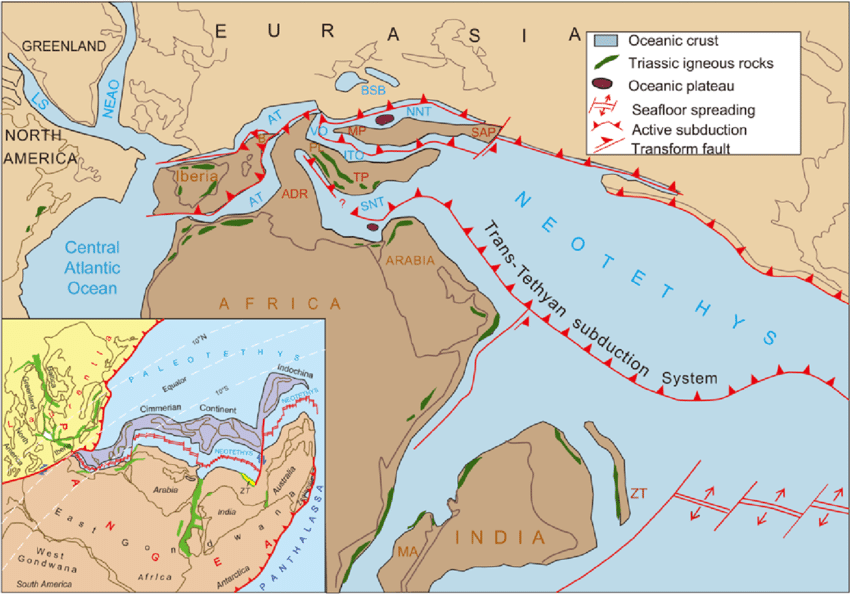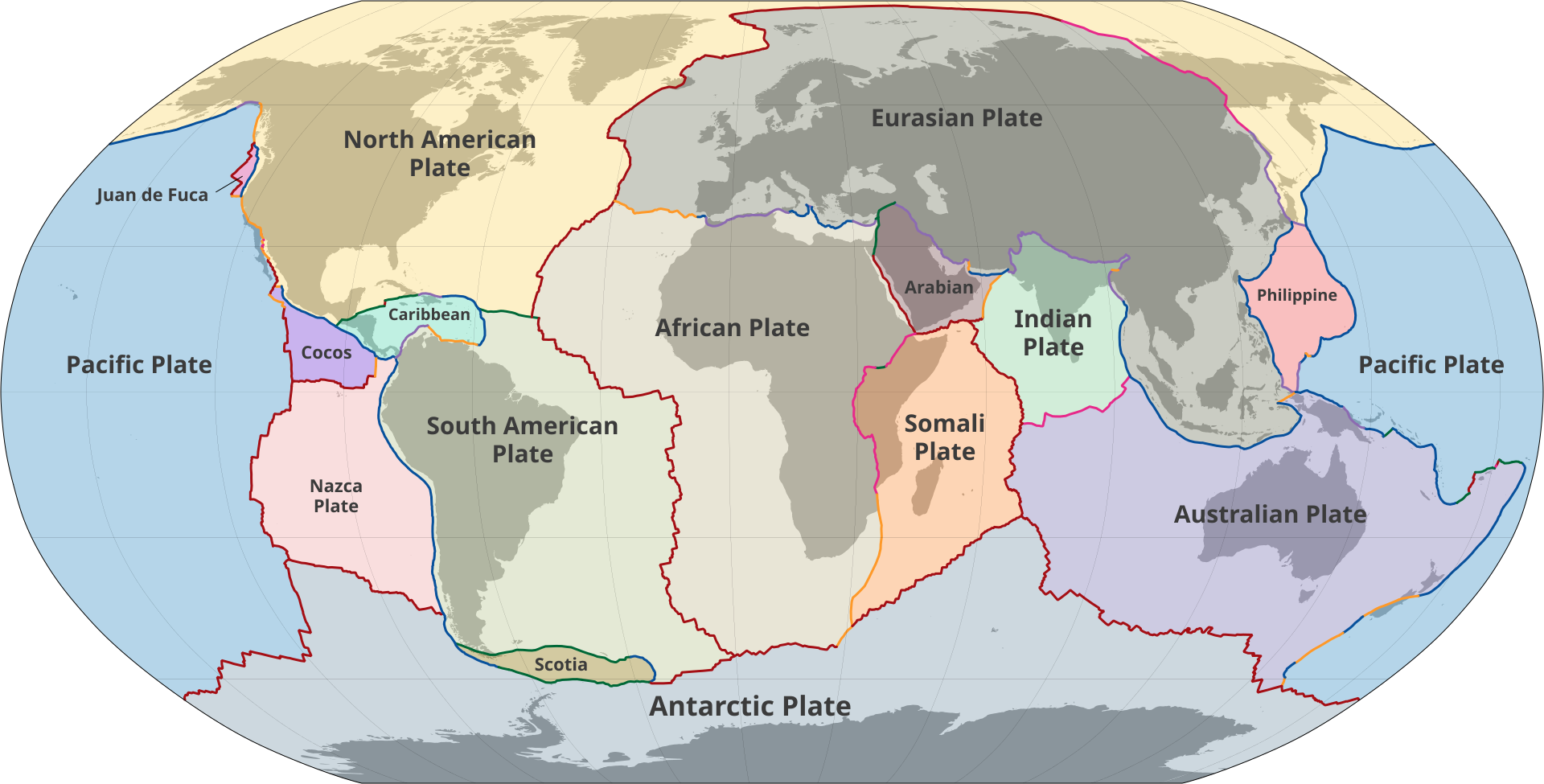Neotethys Oceanic Plate and Tectonic Movements | 19 Feb 2025
For Prelims: Neotethys oceanic plate, Zagros Mountains, Arabian and Eurasian continental plates, Plate Tectonics Theory, Continent Formation.
For Mains: Role of Plate Tectonics and Geological Processes in Continent Formation, Tectonic Forces and the Evolution of Landforms, The Role of Plate Tectonics in the Formation of Himalayas and Its Ongoing Impact.
Why in News?
A study has revealed that the ancient Neotethys oceanic plate, which once lay between the Arabian and Eurasian continental tectonic plates, is breaking apart under the Zagros Mountains in West Asia due to plate movement.
- This impacts regional geography, earthquakes, and resource distribution offering valuable insights into the Earth's deep tectonic processes.
What is Neotethys Oceanic Plate?
- The Neotethys Oceanic Plate was an ancient oceanic plate that once formed the seafloor of the Neotethys Ocean, which existed during the breakup of Pangaea.
- Over time, it was subducted into the Earth's mantle beneath the Eurasian continent as the Arabian and Eurasian plates moved closer.
Arabian Plate:
- The Arabian Plate is a minor tectonic plate in the Northern and Eastern Hemispheres, moving northward along with the African and Indian plates.
- Its collision with the Eurasian Plate has been a major force in mountain formation, contributing to the rise of the Zagros Mountains, Alborz Mountains, Iranian Plateau, Himalayas, and other ranges in Southern Europe and Southeast Asia.
- The heavy weight of the Zagros Mountains has caused the surrounding land to sink, forming the Mesopotamian sedimentary basin.
Eurasian Plate:
- The Eurasian Plate is a major tectonic plate that covers most of Europe, Russia, and parts of Asia, with boundaries shared with the North American, African, Arabian, Indian, and Sunda Plates.
- It has a divergent boundary with the North American Plate in the west and moves at an average rate of 0.25 to 0.5 inches per year, pulling Iceland apart at 2.5 cm per year.
What is Tectonic Plates and its Movement?
- About: A tectonic plate (also called lithospheric plate) is a massive, irregularly shaped slab of solid rock, generally composed of both continental and oceanic plates.
- Continental plates form the Earth's landmasses, while oceanic plates lie beneath the ocean floor.
- Oceanic plates are composed of denser basaltic rocks and subducted beneath continental plates at convergent boundaries, as continental plates consist of lighter granitic rocks.
- Major and Minor Tectonic Plates: Earth's lithosphere is divided into 7 major plates and several minor plates.
- Major Plates: Antarctic Plate, North American Plate, South American Plate, Pacific Plate, Indo-Australian Plate, African Plate, Eurasian Plate.
- Minor Plates: Cocos Plate, Nazca Plate, Arabian Plate, Philippine Plate, Caroline Plate, Fiji Plate, Juan de Fuca Plate, etc.
- Tectonic Plate Movement:
- Movement of Plates: The tectonic plates are not fixed but constantly move horizontally over the asthenosphere as rigid units.
- Their interactions- colliding, diverging, or sliding past each other result in geological events like earthquakes and volcanic eruptions.
- Rate of Movement: Tectonic plates move at varying speeds. The Arctic Ridge has the slowest movement (<2.5 cm/year), while the East Pacific Rise in the South Pacific moves the fastest (>15 cm/year).
- Driving Force: The movement is driven by convection currents in the mantle which occur due to primordial heat from Earth's formation and radioactive decay of isotopes like thorium and uranium.
- Heated material rises, spreads, cools, and sinks, creating a continuous cycle that propels the plates.
- Movement of Plates: The tectonic plates are not fixed but constantly move horizontally over the asthenosphere as rigid units.
- Tectonic Plate Boundaries:
- Convergent Boundaries (Destructive Boundaries): Plates collide, leading to subduction, mountain formation, and volcanic arcs.
- Oceanic-Continental Convergence: The denser oceanic plate subducts beneath the continental plate (e.g., Juan de Fuca Plate subducting under the North American Plate).
- Oceanic-Oceanic Convergence: The denser plate subducts, forming deep trenches and island arcs (e.g., Mariana Trench).
- Continental-Continental Convergence: Collision results in mountain formation (e.g., Himalayas due to the Indian and Eurasian plate collision).
- Divergent Boundaries (Constructive Boundaries): Plates move apart, creating new crust, seafloor spreading, and rift valleys.
- Oceanic Divergence: Mid-ocean ridges form (e.g., Mid-Atlantic Ridge).
- Continental Divergence: Rift valleys emerge (e.g., Great Rift Valley in Africa).
- Transform Boundaries (Conservative Boundaries): Plates slide past each other without creating or destroying crust.
- They often cause earthquakes due to accumulated stress along faults (e.g., San Andreas Fault in California).
- Convergent Boundaries (Destructive Boundaries): Plates collide, leading to subduction, mountain formation, and volcanic arcs.
| Drishti Mains Question: Q. What are convergent, divergent, and transform plate boundaries? Discuss their significance in understanding seismic activity and natural disasters |
UPSC Civil Services Examination, Previous Year Questions (PYQs)
Prelims
Q. Which of the following phenomena might have influenced the evolution of organisms? (2014)
- Continental drift
- Glacial cycles
Select the correct answer using the code given below:
(a) 1 only
(b) 2 only
(c) Both 1 and 2
(d) Neither 1 nor 2
Ans: C
Mains
Q. What do you understand by the theory of ‘continental drift’? Discuss the prominent evidences in its support. (2013)


